INDOXACARB
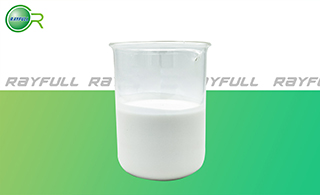 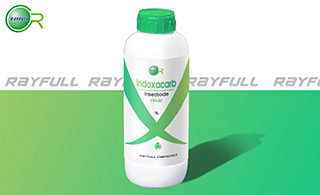 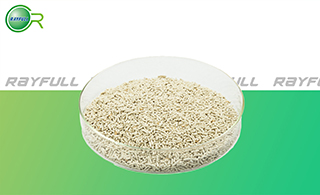 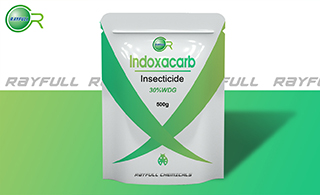 ЬбіжНю ЬбіжНю
Introduction: Indoxacarb is an insecticide for use on a wide range of crops including cotton, brassicas, sweet corn, lettuce, fruiting vegetables, fruit including apples, pears, cherriesto control certain Lepidoptera, cockroaches and ants.
Common name: Indoxacarb
Another name: Steward, Provaunt, Advion,Avatar, Avaunt, Avent, Indoxacarb [ISO], DPX-KN 128, HSDB 7280, DPX-MP 062-381, CHEBI:38630.
Chemical name: methyl (S)-N-[7-chloro-2,3,4a,5-tetrahydro-4a-(methoxycarbonyl) indeno[1,2-e][1,3,4]oxadiazin-2-ylcarbonyl]-4'-(trifluoromethoxy)carbanilate
Empirical formula: C22H17ClF3N3O7
Structural formula:
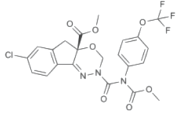
Mol. Weight: 527.83 g/mol
CAS No.: 144171-61-9
Specifications
Leading Indoxacarb supplier
Indoxacarb 150 g/L SC
Indoxacarb 35% WDG
Indoxacarb 30% WDG
Indoxacarb 95% TC
Packing:
BULK PACKING
Powder: 25kg/Bag, 25kg/Drum, 50kg/Drum etc.
Liquid: 200L/Drum, 20L/Drum, 10L/Drum ect.
SMALL PACKING
Powder: 1kg/Alu bag, 500g/Alu bag, 200g/Alu bag, 100g/Alu bag, 50g/Alu bag, 15g/Alu bag etc.
Liquid: 5L/Drum, 1L/Bottle, 500ml/Bottle, 250ml/Bottle, 100ml/Bottle, 50ml/Bottle etc.
Customerized packing label
Indoxacarb FAO standard
Professional registration
HAZARDS IDENTIFICATION
Hazard statement(s)
H301: Toxic if swallowed.
H317: May cause an allergic skin reaction.
H332: Harmful if inhaled.
H372: Causes damage to organs through prolonged or repeated exposure.
H410: Very toxic to aquatic life with long lasting effects.
Precautionary statement(s)
P260: Do not breathe dust/fume/gas/mist/vapors/spray.
P261: Avoid breathing dust/fume/gas/mist/vapors/spray.
P264: Wash ... thoroughly after handling.
P270: Do not eat, drink or smoke when using this product.
P271: Use only outdoors or in a well-ventilated area.
P272: Contaminated work clothing should not be allowed out of the workplace.
P273: Avoid release to the environment.
P280: Wear protective gloves/protective clothing/eye protection/face protection.
P301+P310: IF SWALLOWED: Immediately call a POISON CENTER/doctor/...
P302+P352: IF ON SKIN: wash with plenty of water.
P304+P312: IF INHALED: Call a POISON CENTER/doctor/... if you feel unwell.
P304+P340: IF INHALED: Remove person to fresh air and keep comfortable for breathing.
P312: Call a POISON CENTER or doctor/... if you feel unwell.
P314: Get medical advice/attention if you feel unwell.
P321: Specific treatment (see ... on this label).
P330: Rinse mouth.
P333+P313: IF SKIN irritation or rash occurs: Get medical advice/attention.
P363: Wash contaminated clothing before reuse.
P391: Collect spillage.
P405: Store locked up.
P501: Dispose of contents/container to ...
Supplemental Hazard Statements: none
MAMMALIAN TOXICOLOGY
Acute toxicity: 1) Acute oral LD50 for rat: 268 a.i.mg/kg. 2) Acute dermal LD50 for rat: >5000 a.i.mg/kg. 3) Inhalation LC50 (4 h) for rat: >5.5 a.i. mg/L. 4) Slightly-irritating to skin (rabbits). 5) Slightly-irritating to eyes (rabbits). 6) Not a skin sensitiser (guinea pigs). No significant toxicological effects in 90 day studies were found below the recommended guidance values for classification. Tests on bacterial or mammalian cell cultures did not show mutagenic effects. Animal testing did not show any mutagenic, carcinogenic, reproduction effects. Animal testing showed effects on embryo-fetal development at levels equal to or above those causing maternal toxicity.
ADI(JMPR): 0.04 mg/kg b.w. [2014]
Classification:
Toxicity class WHO (a.i.): II (Moderately hazardous)
US EPA Classification (formulation): III (Caution - Slightly toxic)
EC Risk Classification: Xn - Harmful: R22; N - Dangerous for the environment: R51/53
ECOTOXICOLOGY
Effect on birds: high toxicity to birds, acute LD50 for Colinus virginianus is 98 a.i.mg/kg. Effect on fish: moderate toxicity to fish, acute 96 hour LC50 for Rainbow trout is 0.65 a.i.mg/L. Effect on aquatic invertebrates: moderate toxicity to aquatic invertebrates, acute 48 hour EC50 for Daphnia magna is 0.6 a.i.mg/L. Effect on algae: moderate toxicity to algae, acute 72 hour EC50 for Raphidocelis subcapitata is 0.11 a.i.mg/L. Effect on honeybees: high toxicity to honeybees, contact acute 48 hour LD50 is 0.094 a.i.ҰМg/bee; Oral acute 48 hour LD50 is 0.26 a.i.ҰМg/bee. Effect on earthworms: moderate toxicity to earthworms, acute 14 day LC50 for Eisenia foetida is >625 a.i.mg/kg.
ENVIRONMENTAL FATE
Indoxacarb's production may result in its release to the environment through various waste streams; it's use as an insecticide will result in its direct release to the environment. If released to air, a vapor pressure of 1.9ЎБ10-10 mm Hg at 25 deg C indicates indoxacarb will exist solely in the particulate phase in the ambient atmosphere. Particulate-phase indoxacarb will be removed from the atmosphere by wet and dry deposition. If released to soil, indoxacarb is expected to have no mobility based upon an estimated Koc of 8,100. Biodegradation data were not available. Volatilization from moist soil surfaces is not expected to be an important fate process based upon an estimated Henry's Law constant of 6.6ЎБ10-10 atm-cu m/mole. Indoxacarb is not expected to volatilize from dry soil surfaces based upon its vapor pressure. If released into water, indoxacarb is expected to adsorb to suspended solids and sediment based upon the estimated Koc. Volatilization from water surfaces is not expected to be an important fate process based upon this compound's estimated Henry's Law constant. An estimated BCF of 2,000 suggests the potential for bioconcentration in aquatic organisms is very high. Aqueous hydrolysis half-lives measured for indoxacarb were greater than 30 days at pH 5, 38 days at pH 7, and 1 day at pH 9. Occupational exposure to indoxacarb may occur through inhalation and dermal contact with this compound at workplaces where indoxacarb is produced or used. Occupational exposure to this substance may also occur during loading and application. The general population may be exposed to indoxacarb through contact with crops that have been treated with this insecticide. The general population may also be exposed to indoxacarb via inhalation of ambient air, ingestion of food and drinking water, and dermal contact with this compound and other products containing indoxacarb.
Usage: Indoxacarb is an oxadiazine pesticide developed by DuPont that acts against lepidopteran larvae.
Application: Indoxacarb is a broad-spectrum pesticide that can be used in control sucking insects like Bollworm, Pink bollworms, Spotted bollworms, Cutworms, including Heliothis, lacanobia, Fruitworm, White apple leafhopper, Codling moth , Pandemis leafroller etc in various crops like cotton, fruit trees, and vegetables etc. 22.5-40.5 g/ha can be used to control cabbageworm and cotton bollworm in cruciferous vegetable and cotton.
| 






